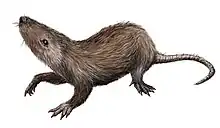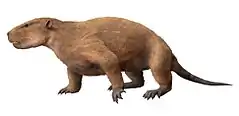Parikimys
Parikimys carpenteri is a multituberculate which existed in Colorado at the end of the Cretaceous period.[1] The species is named "in honor of the DMNS vertebrate paleontologist Ken Carpenter, whose initial field work in the sparse, non-marine Cretaceous exposures of Weld County inspired this project."[2]
| Parikimys carpenteri Temporal range: | |
|---|---|
| Scientific classification | |
| Kingdom: | |
| Phylum: | |
| Class: | |
| Order: | |
| Family: | |
| Genus: | Parikimys Wilson et al., 2010 |
| Species: | P. carpenteri |
| Binomial name | |
| Parikimys carpenteri Wilson et al., 2010 | |
While the species shares several morphological characteristics with Mesodma, there are a few characters that set it apart. Parikimys is known from a well preserved left dentary containing p4-m2 as well as p3 alveolus. The species differs from similar taxa (Mesodma) based on pyramidal shaped cones on the m1, which are similar to Cimolodon and more primitive than Mesodma . The mesial aspect of the crown is narrow and forms a V-shaped concavity received the distal end of the p4. The cusps of the internal row are mesiodistally offset from the external row and are distinctly taller than the medial row as well.
A second locality in southern Wyoming described Parikimys, but with specimens roughly 20% smaller than those of the original.[3] Full access
References
- Gregory P. Wilson, Marieke Dechesne & Ingrid R. Anderson (2010). "New Late Cretaceous mammals from northeastern Colorado with biochronologic and biogeographic implications". Journal of Vertebrate Paleontology. 30 (2): 499–520. doi:10.1080/02724631003620955. S2CID 92991955.
- Wilson et al., 2010, op. cit.
- Donohue; et al. (2013). "Latest Cretaceous multituberculate of the Black Butte Station local fauna (Lance Formation, southwest Wyoming), with implications for compositional differences among mammalian local fauna of the Western interior". Journal of Vertebrate Paleontology. 33 (3): 677–695. doi:10.1080/02724634.2013.745416. S2CID 55614488.

